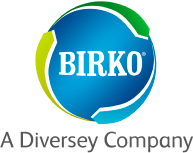Cleaning kegs in breweries has traditionally been accomplished by using hot water and alkaline liquid cleaning solutions comprised of sodium and or potassium hydroxide. Sodium hydroxide (NaOH) and potassium hydroxide (KOH) utilize extremely high (12-14) pH to hydrolyze (break down) soil to remove it. Sodium hydroxide is also known as caustic soda or lye and potassium hydroxide is known as caustic potash. In the last few decades, formulators have included surfactants, (detergents) and sometimes chlorine bleach (sodium hypochlorite) along with the caustic to assist wetting and protein removal. A decade ago, craft brewers began using a new generation of non-caustic, alkaline, oxygenated cleaning solutions instead of using caustic. (See The New Brewer, March/April, 1996). These powdered non-caustic alkaline cleaners are safer for employees than their caustic predecessors due to their lower pH at use level.
Caustic cleaning solutions are used in the brewery because they are relatively inexpensive, can be recycled (re-used) and do a good job of removing protein-based soils. They do not, however, address calcium and magnesium hard water scale deposits nearly as well as acidic cleaning solutions. Non-caustic cleaners tend to cost more per pound than caustics do but they do not promote beerstone (calcium oxalate or C2CaO4) formation as much as caustics. Non-caustic cleaners are not normally recycled because the cleaning mechanism utilized is displacement, not hydrolysis like caustics employ. Acids blends, often containing phosphoric and nitric acid, are commonly used in the brewery to remove beerstone deposits, passivate metal, (stainless steel), and neutralize caustic cleaners. Unlike alkaline cleaners, however, acids by themselves are not usually very good at removing protein-based soil that are encountered in the brewhouse and fermentation vessels.
Once the fully fermented beer has been allowed to get cold and age, the soil left behind does not have nearly as much protein soil, especially if the beer is filtered or fined to remove much of the yeast and protein. Here, the primary problem soil in brite tanks, serving tanks, kegs, and tap lines is beerstone. Given the fact that the soil in kegs is primarily calcium and magnesium scale in nature and the cleaning cycle time is typically very short, one would surmise that using an acidic formulation might be a better choice than using either caustic or non-caustic cleaners in this scenario.
Avery Brewing Company, based in Boulder, Colo, recently purchased a new Comac keg cleaning and sanitizing machine. To reduce chemical costs and attempt to remove the beerstone deposits in the kegs, Avery contacted Birko to try an acidic and detergent approach instead of the chlorinated caustic approach that they had been using with the previous machine. The previous machine did not recycle the cleaning chemical. It simply drew the chemical into the line and was not recycled, so the cleaning chemical went immediately down the drain at the end of the cleaning cycle. Using this approach, it was taking 190 ml (over 6.4 ounces) of chlorinated caustic per keg and since the machine did not have a reservoir for recycling chemical so it was very wasteful.
The new machine, which has a 60 gallon reservoir for recycling chemical was charged with one gallon of acid and two ounces of detergent additive. The concentration works out to 2 ounces per gallon of the nitric/phosphoric acid blend and only about 250 parts-per-million (ppm) of the detergent additive. The pH of the use solution was 1.0 – 1.5 and tested out to 3000 ppm as phosphoric acid using the LaMotte Acidity test kit.
The machine does a purge to remove any remaining beer and carbon dioxide from the keg, does a hot rinse, cleaning cycle, three burst rinses followed by a steam sanitizing cycle. It takes very little chemical using this approach. While this may not be good news for our chemical sales, it is very good for the environment and the brewer’s bottom line, especially.
Cost Comparison: Old Chemical Method Versus New Chemical Method
190 ml. of chlorinated caustic per keg works out to 6.33 fluid oz. per each keg: (190 ml./ 30 ml/oz = 6.33 oz.) Avery was paying $6.95 per gallon for Chlorinated caustic in the 30 gallon drums. So, this works out to a use cost of $0.34 per keg. ($6.95/128 oz. per gal. = 5.43 cents per oz. x 6.33 oz. = 34.37 cents per keg.
The bad news was that there was a lot of caustic going down the drain, which probably had some life left in it. Plus, caustic did not address the beerstone issue as much as acid (especially nitric acid) does). So, let’s take a look at nitric/phosphoric/detergent. Nitric/phosphoric/detergent costs $7.40 per gallon in the 30 gallon drum. This gives us a cost per oz. of 5.78 cents: ($7.40/128 oz. per gal. = 5.78 cents). Wait a minute, that’s more money than chlorinated caustic! True, but wait, there’s more, nitric/phosphoric/ detergent does a great job on beerstone, plus it CAN BE RECYCLED!
For comparison sake, let’s say we start with a comparable amount of nitric/phosphoric/ detergent to start with. Here’s the cost calculation: 5.78 cents per ounce x 6.33 oz. = 36.58 cents per keg. The bad news is it is more money than chlorinated caustic to start. The good news is, again, is that it can be recycled and you don’t have to worry about C02! I know what you are thinking. Cut to the chase, Dana. OK, I will. Guess what? That nitric/phosphoric/detergent solution doesn’t go have to immediately down the drain, unless you want it to.
Let’s look at the cost of 10 kegs with chlorinated caustic vs. Nitric/phosphoric/detergent:
Chlorinated caustic: 10 x 34.37 cents per keg = $3.44 (10 x 34.37 cents per keg = $3.44 to clean 10 kegs).
Nitric/phosphoric/detergent: 10 x 36.58 cents = $3.66 (10 x 36.58 cents per keg = $3.66/10 kegs.) I think we can do 10 more than kegs with nitric/phosphoric/detergent? I definitely think so, as long as we keep the pH below 2.
Assuming we can do at least 20 kegs on that solution, let’s cut that cost in half: $3.66/20 = 18.3 cents per keg.
Cost comparison savings (in cents per keg: 34.37 (Chlorinated caustic cost / keg) -18.30 (Nitric/phosphoric/detergent cost / keg) = 16.07 cents saved in cleaning chemicals per keg.
Big Picture Cost Savings:
16.07 cents x 10 = $1.60 for 10 kegs.
$1.60 x 10 = $16.00 for 100 kegs.
$16.00 x 10 = $160.00 for 1000 kegs.
Seems like a pretty good savings, huh? But wait, there’s more. Avery was actually able to clean many more kegs out of the solution than even I anticipated they could. Unbelievably, the charge lasted for over 700 kegs without needing to be recharged! Here’s an email I received in late December, 2007 from Steve Wadzinski at Avery:
Handtruck (aka Matt Thrall) mentioned awhile ago that you’d like some info on how many kegs were are washing vs. Ultra Niter usage. Well here’s what I’ve got for you.
First we had initially at the beginning of each week drained half the acid reservoir and then refilled and added 64 oz of Ultra Niter. This would gradually over 4-6 weeks reduce the strength on the methyl orange test down from 8 drops to 5 drops.
On 11/5 I drained the tank entirely and found a small amount of solids on the bottom but not much over all having gone at least 2 months without completely draining.
I then filled with 60 gallons of water and added 1.5 gallons of Ultra Niter. This got me a pH of 1.3 and 8 drops on the methyl orange test.
We then washed 209 kegs and 68 pins w/e 11/9, followed by a 7 drop methyl orange test.
We then washed 119 kegs and 32 pins w/e 11/16, followed by another 7 drop test.
We then washed 104 kegs and 46 pins w/e 11/23, followed by a 6 drop test.
We then washed 27 kegs and 36 pins w/e 11/30, followed by a 6 drop test.
We then washed 102 kegs and 42 pins w/e 12/4, followed by a 5 drop test.
At that point I decided to add more acid and drained 1/2 the reservoir, refilled and added 1 gallon of Ultra Niter to get us back to 8 drops. This whole time we got a 1.3 pH, no change there.
In total we got 561 kegs and 224 pins out of 1.5 gallons of Ultra Niter for a total of 785 wash cycles.
Author’s Note: That comes out to 0.25 ounces (about 8 ml.) per keg. (Remember: They were using over 6 oz. [190 ml.] per keg with the previous keg cleaning regime!)
Hope that’s the kind of info you’ve looking for.
Since the actual savings ended up being double what I had anticipated before the project began. Let’s take another look at the cost savings:
Chemical Cost Recalculation:
$11.10 + $0.21 = $11.31/785 wash cycles = 1.44 cents per keg.
Old Method using chlorinated caustic: $34.37 cents per keg
New method using nitric/phosphoric/detergent: 1.44 cents per keg
Savings: $32.92 cents per keg
32.92 cents x 10 = $3.29 for 10 kegs.
$3.29 x 10 = $32.90 for 100 kegs.
$32.90 x 10 = $329.00 for 1000 kegs.
Since the last email from Steve was at the end of last year, I decided to check in with Avery so see how things were going. Here is 5/15/2008 email update from Steve Wadzinski:
Actually after looking at the savings of running the chemicals to the edge before strengthening we made it easy on ourselves and decided to just dump the reservoir and start fresh every 2-3 weeks depending on keg volume. We may be dumping perfectly good solutions but the price of Ultra Niter makes it easy to stay on the strong side and clear out the reservoir on a more frequent basis. We haven’t been tracking since that first test.
Conclusion:
Keg cleaning is very important to ensure the shelf life of the beer out in the market. Because of their size, kegs are not pasteurized. Unfortunately, beerstone in kegs is a ubiquitous problem for brewers. This new approach not only does a better job of removing and keeping beerstone out of kegs, it is much more economical as well. The chemical savings per keg cleaned is dramatically less then the previous method and is better for the environment as well since there is far less chemical going down the drain. With water and sewage costs rising along with everything else, this new method of cleaning kegs appears to be a win, win, win situation. It is cheaper, safer, less expensive, not to mention the fact it is just as or more effective than using chlorinated caustic. In the eight months since Avery switched to this keg cleaning regime, they have not had any complaints or off-flavor problems with beer and they have saved a lot of money on chemicals too!





